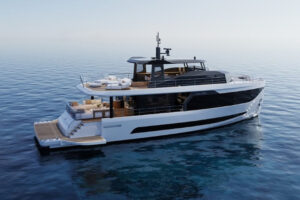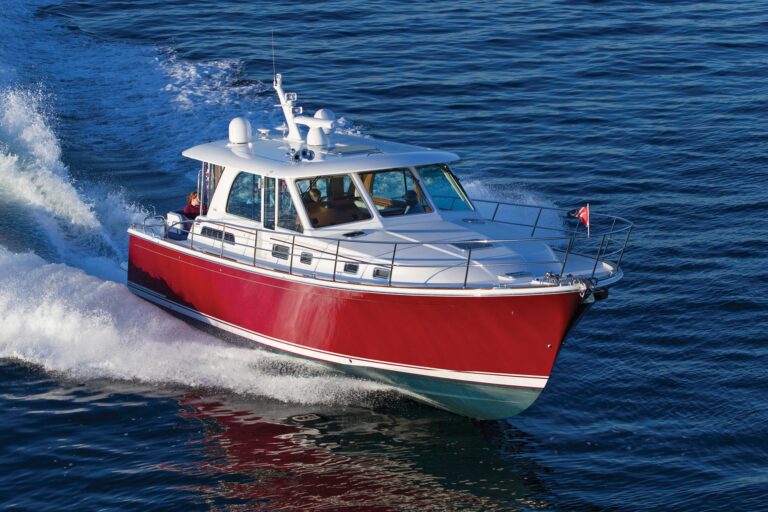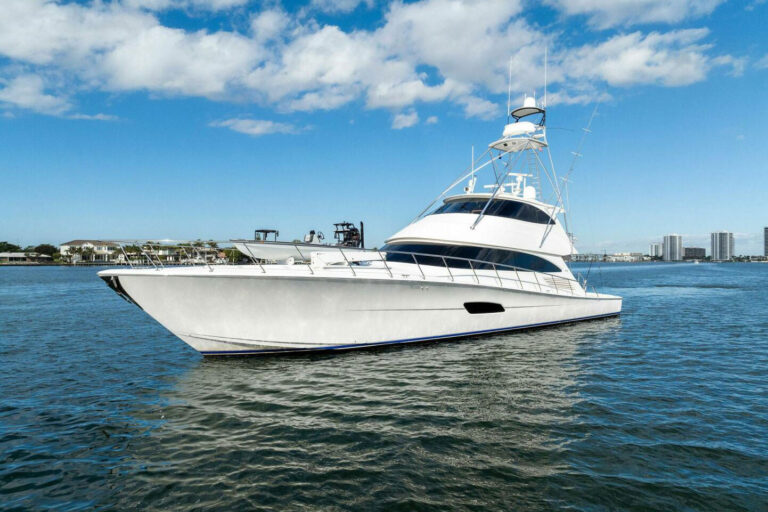
Uniesse 53
I had wandered through the new Uniesse 53 Motoryacht until I found myself in the master stateroom. It was dark and cool on that hot Florida afternoon, and I pulled the cord to roll up the Roman-style drapes. As the light flooded in, I was suddenly transported to another world.
It was 1954 and I was absorbed by the Saturday matinee, where a buck still covered admission, popcorn, M&M’s and a Coke. The movie was the now-classic Walt Disney version of Jules Verne’s 20,000 Leagues Under The Sea. American whaler Ned Land, played by chisel-chinned Kirk Douglas, had ventured into the saloon of the Nautilus, Capt. Nemo’s submarine. There he had found the immense round, underwater windows that allowed guests to recline on the velvet seats and admire the undersea creatures passing by.
Half a century has passed, and I’m still blown away by that eye-opener of a concept-my first brush with design. And, aboard the Uniesse 53, I found my dejà vu thanks to three large windows just above the waterline in the master suite on each side. Truly a wonderful idea, almost invisible from outside so as not to mar the sleek lines, they transform the suite into a wonderful getaway that makes you wish you could wake in the king berth to a view of a sand beach and palm trees, or perhaps the waterfront of Portofino.
The Uniesse 53 is an unusual yacht, not the least for the amount of living space that has been fitted in without losing the girlishly trim lines. Our test boat had the optional layout with full-beam master suite, VIP stateroom, two-bunked guest cabin and two full heads. That’s a lot to shoehorn into a modest 15-foot beam and, like anything clever, it involves some trade-offs.
In the European fashion, the three-panel sliding door from the cockpit opens wide to turn the saloon into an extension of the teak-planked cockpit. Glance around the saloon, past the U-shaped settee with the high-low table, over the creamy leather upholstery, and up to the raised helm level. It’s all quite wonderful, but something seems to be missing. After a moment it hits: the galley!
But no, the Italians have simply concealed the galley by tucking it under a counter that stretches the length of the saloon to starboard. Pop up the counter (on gas-assisted lifts) and the prospect of breakfast, lunch and dinner reappears on the event horizon. A three-burner cooktop is aft with a metal heat shield under the fold-up counter (but none on the nearby high-gloss bulkhead, which should be considered). There’s plenty of space on the Botticino marble counter, a stainless steel sink at the forward end with folding mini-faucet, a pair of Sub-Zero fridge/freezers under the counter and a microwave in a locker aft. A large but undivided bin handles cookware, five plastic drawers will hold utensils, and shallow overhead cupboards are fitted for glasses and plates. Americans may find the layout a bit Spartan, but Europeans (who like to eat ashore a lot) find this kind of arrangement quite practical; it should suit the casual weekender just fine.
Tap the switch on the aft bulkhead, and you’ll see why the Italians like this design: A Sony 20-inch flat-screen TV descends directly over the galley counter from its lair in the overhead cabinets. It’s a perfect position for watching from the dinette, and keeps you from ruining a romantic dinner by watching Jeopardy. The interior is finished in high-gloss Tanganyika, a wood that has become a trademark of Uniesse and the joinerwork is superb. A pale and straight-grained wood also known as anigre, it’s both rare and beautiful.
The helm level is raised, with a settee opposite the port helm and a clever notch behind the helm seat (more later). The settee is quite comfortable, with low backrests that provide the sort of lumbar support too often missing in cruising yachts.
The single-seat helm faces a burled dash with plenty of space for electronics on the vertical panel and Caterpillar screens on the horizontal. Just outboard of the seat is a horizontal electrical panel with the breakers labeled in both English and Italian. As for the notch behind the helm seat, it holds an icemaker behind one door and fridge/icemaker behind the other. Another example of clever concealment, it also makes good use of the space used on the standard Euro layout that would be taken up by a stairwell to the lower deck galley and crew cabin (which will probably never be used in North America).
The centerline stairs lead to the accommodations, which ought to please anyone with their tidy and efficient passageways. And I loved the master suite. Besides the Capt. Nemo windows, it spans the full beam and seems to have even more room than the actual dimensions would permit. This particular yacht had a mini-dinette to starboard with two seats and a small table rather than the predictable settee shown on the plans-a recent trend from the Italians, who seem to have discovered the pleasures of the breakfast nook (which could also be a champagne nook, depending on the hour). A great place to have a morning croissant and coffee, enjoy a private cocktail or simply catch up on your diary while enjoying the view.
When you first enter the suite, you’re actually on a level above the suite itself, and this space has been allocated as a dressing area complete with a huge, almost walk-in, closet; a full-length mirror; and a second hanging locker. It’s a clever use of space, particularly the way they’ve placed the private master head just forward on the same level.
And this head really delighted me, giving off something of the same ambiance as Capt. Nemo’s undersea aquarium. Uniesse’s construction and design again triumph with a look that is trendy, a symphony of blues and steel and teak, and very comfortable: The two-door shower is amply sized with teak grating on the sole, and the molded bulkhead paneling is glamorous and, to me, dramatic. The floor is nonslip-finished Tanganyika.
Forward, the VIP stateroom has an island berth, two tall hanging lockers, three plastic bureau drawers underneath, and direct access to the day head that is sized and furnished like the master. The joinery and construction are, again, a joy to behold-and to touch. Just off the lower foyer to starboard is the two-bunk cabin, which is fitted with a tall, hanging locker and two drawers under the lower berth.
Back outside, the cockpit has big storage lockers on each side plus two line lockers under the corner cleats, a bench seat aft and a cantilevered bridge overhang that is nicely finished on the underside. The transom coaming hinges up to reveal an Opacmare 675-pound crane suitable for launching a RIB from the transom platform.
Molded steps lead to the flying bridge, which is surprisingly large for a yacht of this size. The portside helm has a double, wide seat behind a simple molded fiberglass console marked by the wood-rimmed metal-style wheel.
Opposite the helm is a spacious sunpad, but I was surprised that it couldn’t be tilted up to provide either a fore- or aft-facing backrest. The result is that anyone wanting to ride next to the skipper has to be either prone or sitting on the low sunpad without a backrest.
On the other hand, the wraparound settee aft with its round, plastic cocktail table is very comfortable, so leave the skipper alone to drive the boat up forward. On the port side of the bridge is a fiberglass console that holds the usual barbecue grill, sink and icemaker/fridge.
Down on deck, the walkarounds are well protected by the welded and socketed stainless steel double rails that extend literally from bow to stern. Because the bridge overhang narrows the shoulder space on the walkarounds, the 53 could benefit from inboard grab rails, perhaps concealed under the overhang. Once forward, there is a big sunpad on the house as well as a Lofrans windlass and stainless steel anchor roller at the bow. An absolutely huge gear locker is forward with its own washdown bib, and it also provides great access to the chain locker in case of a tangle.
One place you’ll have trouble believing this is a 53-footer is when you venture into the engineroom, which is downright huge. Descend via stairs from the cockpit hatch, and you’ll find yourself in a gear flat aft of the engineroom proper. Here you’ll find the 9 kW Onan genset in its sound box, the MarineAir a/c system, and a host of neatly arranged filters, shut-offs and manifolds. You can actually touch the steering rams, too.
Access outboard of the Caterpillar C-12s is limited, but all the service features have been moved to the inboard sides and this compact version has the heat exchanger moved as well. I’d like to see a smooth finish in the bilge (or oil pans) to catch the inevitable dribbles, but the workmanship is tidy and seamanlike. Standard power is a pair of MAN 700 hp diesels but our test boat had Cat 710s driving through a ZF V-drive.
Under way, the Uniesse 53 was both pleasant and well mannered. Roll on the throttles and the yacht lifts smoothly onto plane without needing trim tabs for anything other than balancing out windage or the weight of guests on one side.
Considering that the saloon had hardwood floors with no carpet or soft goods to dampen the sound, the low sound levels were indicative of an effort made to insulate the engines and exhausts. On the bridge, our sound meter registered little except wind and water: Even at full throttle, the engines were a distant hum. As you can see on the performance chart, we topped out just shy of 33 knots, which is certainly more than respectable for a yacht of this size.
The Uniesse 53 is well built, sea kindly, and has an interesting and unusual layout with a number of thoughtful features that I’d like to see on more yachts. She’s not for everyone, but I know that both Ned Land and Capt. Nemo would love her-and many couples will find her the epitome of Roman romance. Contact: Global Maine Group, (305) 371-2628; www.globalyachts.com.








